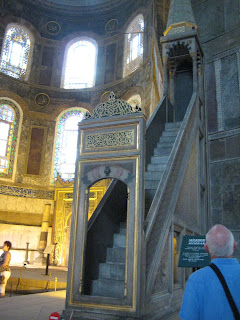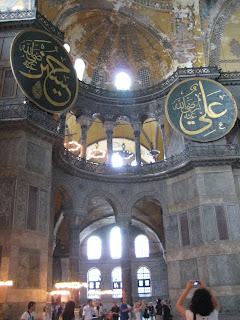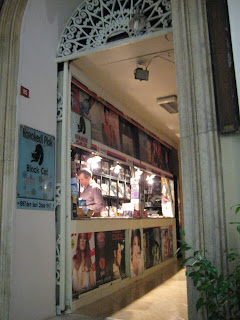
Theodosius II ordered a second church built (with a wooden roof... did we learn nothing from the first fire?), and inaugurated it in 415. This second version of the Hagia Sophia was burnt down during the Nika Revolt (or as it said on an informational sign in the Hagia Sophia, the "Nike" Revolt.) The revolt was the biggest Constantinople had seen up to that point, nearly half the city was burned and tens of thousands killed during the week-long riot.

(current repairs on the dome- check out that scaffolding!)
Only a month or so after the Nika revolt, Emperor Justinian I decided to build a new and way more impressive basicila. He hired a physicist and a mathematician as architects, used over 10,000 workers had stones and marble brought from quarries in Egypt, Syria, Greece, and areas by the Bosphorous. He even sent to Ephesus for the Hellenistic columns from the Temple of Artemis. This new church was recognized as one of the great works of architecture in its day, particularly for its impressive dome. Justinian and the Eutychius (the new patriarch of Constantinople) inaugurated the new church in 537, complete with all the frills and fanciful ceremony they could muster.


Fast forward through a lot of earthquakes, repairs, political uproars, more fires, swooning foreign visitors, etc to the year 1453, when the Ottoman Turks took Constantinople and the Hagia Sophia magically become the Ayfasofya Mosque. Sultan Mehmed II had the church cleaned up and repaired for its conversion to a mosque. A series of sultans did repairs and improvements over the next 100 years or so. Can I just pause to mention the longest reigning sultan of the Ottoman empire, who was called Süleyman the Magnificient. Süleyman the Magnificient? Are you serious? We need to start giving more descriptive titles to our politicians. Please enjoy this picture of Süleyman the Magnificient, attributed to the school of Titian c.1530.

Sultan Mahmud I did more restorations in 1739, including the addition of a Koranic school, a soup kitchen, a library, a fountain (the kind you use to clean before you pray), a sultan's gallery, etc. Sultan Abdülmecid ordered the last big set of restorations from 1847-1849, doing all kinds of clean-up, replacing chandeliers, straightening columns, and redecorating to include the huge disks that still hang from the upper level of the Hagia Sophia, on which are written the names of Allah, Mohammad and the first four caliphs. Rivaling the hilarity of Süleyman the Magnificient's headdress, there was also a timekeeper's building built in the courtyard. Thats right, a building just for the guy who reminds you what time to do the azan.



During Emperor Barack the Fantabulous' recent visit to Turkey, he came to the Hagia Sophia and befriended one of several cats that lives there, named Gli. Gli seems to own the building and everyone in it. Notice her just sitting on some random guy.















































